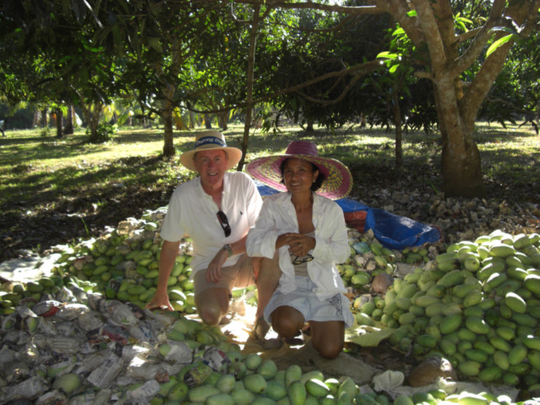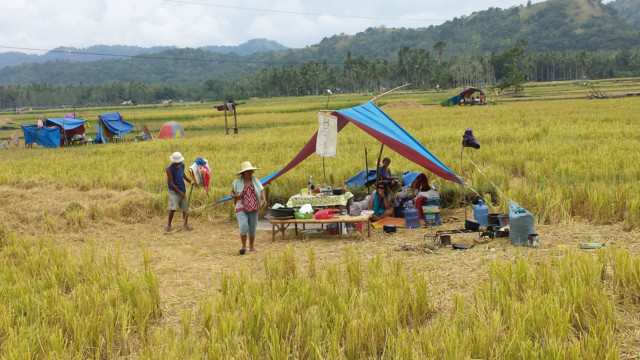
Life can change in a flash. For us it took less than a minute. It was a beautiful sunny morning on October 15, 2013, at Calunasan Creek Farm.
We had been up early planning the day’s activities, when all of a sudden our home started to shake. I recall a deep rumble before the ensuing mayhem took hold. The building shook violently for what seemed like an age, causing ceilings to collapse, windows to blow out, and walls to crack and crumble as our belongings and all that we had built in the preceding six months crashed around us. Such is the frightening power unleashed by an earthquake of 7.2 on the Richter scale.
Trapped under the debris on the upper terrace, I could hear a voice screaming “Where are you?”, as I too wondered where was she. Flor was trapped in the bathroom unable to escape. We were helped out of the house, badly shaken but miraculously unhurt apart from minor cuts and bruises.
Word quickly spread from the village that the sea had receded and a tsunami was feared. We followed villagers rushing up the hill behind the farm where we gathered next to a church and a group of homes mostly destroyed.
As the ground continued to rumble and shake with each aftershock, the people roared “bwah bwah bwah” to ward off the evil spirits. Everyone was in shock, children were crying, dogs were howling, no one knew what would happen next.
The tsunami never came for we later learnt the epicentre was inland and some 25 kilometres to the east of us, near Sagbayan, a town that suffered severe damage.
The full force of the quake was projected southwest towards the coastal municipality of Loon and surrounding towns. Clearly, our part of the island had taken the brunt of it while our island capital — Tagbilaran City — and the tourist island of Panglao were largely spared.
Nevertheless, Bohol was brought to a grinding halt. The quake caused infrastructural damage worth hundreds of millions of dollars — flattening more than 20,000 houses — and loss of life.
Along with most local folk, we spent the next couple of weeks under canvas while the aftershocks were at their most severe. With no power or running water and our deep water well collapsed we depended on rainwater harvested from the roof of our badly damaged home.
Although roads were badly damaged and bridges were down, we were able to get about and check on Flor’s family, our friends and villagers — all in disbelief as to what had happened to our beautiful island of Bohol.
While many were lucky to be alive, too many others were not so fortunate. In the local town of Loon, more than 40 parishioners were attending early morning mass in the old Spanish church when it collapsed burying them all — none survived.
A week later it started to rain as tropical depression “Wilma” took hold. With homes destroyed or at best damaged, most folk were afraid to move back indoors for fear of further damage from the numerous and often terrifying aftershocks.
We received a frantic call from Flor’s niece. The canal behind their quake-shattered home had burst its banks. We rushed to their village, the road across the rice fields already badly flooded.
With no power and already dark we could only be guided by the occasional flashlight and screams for help.
We found Flor’s elderly parents chest-deep in the rapidly rising water. We rescued them and as many others as we could fit into our jeep and managed to find some spare floor space in the only part of our house safe enough to enter.
Wilma caused widespread flooding and misery for those already reeling from the quake.
And then just 2 weeks later, as if Bohol needed to be punished again so soon, we heard news of a typhoon heading directly at us. “Yolanda” was gathering strength offshore. Friends furiously texted from Manila with updates, as we anxiously watched Yolanda being upgraded from super typhoon to monster typhoon to one of the most powerful storms ever.
This was an unreal and especially frightening scenario for those of us in the already quake-shattered areas of Bohol. The mayor ordered evacuation, but where should we all go? The local school was designated a meeting place but that had been flooded by Wilma and was also damaged in the quake.
We went to stay with good friends who live on slightly higher ground although still not far from the coast. The four of us huddled together on the terrace with the wind swirling around us, palm trees swaying and the rain beating down.
It was a surreal experience as the ground still shook violently from the aftershocks. With no power and no light in the dead of night, it truly felt like the end of the world was upon us. While we anxiously waited for the tin roof to be ripped off, I recall none of us spoke much, all immersed in thought as to what would happen and how we would survive.
Miraculously, Yolanda veered north shortly before landfall. Bohol was spared her full fury while the world watched in horror at the cataclysmic damage unleashed on Tacloban City and the islands of Samar and Leyte.
For a deeply religious society such as Bohol, it is sad to see practically every place of worship either collapsed or rendered unsafe, particularly the historical churches built so long ago by the Spanish. But, in our view, worse than this is the destruction of homes of folk for whom rebuilding is but a dream.
After the sacks of rice and packaged noodles had been handed out, duly stamped with the names of politicians ever keen to attract votes, it quickly became apparent that local and federal authorities would do little or nothing to help local folk rebuild their homes. And so B’s Bohol Earthquake Charity was born.
We have since been overwhelmed by the astonishing response from friends and family worldwide. Our simple little charity has received donations exceeding Php1.35 million (Dh111,643) enabling us to fund the purchase of building materials for more than 80 homes.
Every little bit helps. If we can do a whole lot of little bits together we will help rebuild a village.
Six months on and we still have aftershocks. Just recently our damaged house was hit again by a mighty jolt. Although less frequent than before, shattered nerves are quickly shaken once again, as if we need to be reminded about what has passed.
We know of many who lost everything — local people of course but also foreigners who came here to retire like us. Colin, aged 75, from Devon and his Filipina wife are still living in a tent while they build a simple new home next to their shattered house.
The two-storey retirement home of German friends from Bavaria collapsed like a pack of cards. They were spared since it was market day in the local town and they had gone shopping ten minutes before the quake. They too are living in a tent and are likely to remain that way for the rest of the year.
Filipinos seldom complain about the cards they have been dealt. Many will continue to live in homes that some would perceive to be uninhabitable. Their resilience is remarkable and a lesson to the rest of us who are more fortunate and yet readily moan and groan about trifling issues.
For all of us in Bohol, life will never be quite the same. Meanwhile, time moves on — after the rebuilding of our own shattered home later this year here at Calunasan Creek Farm, we are hoping for a good mango harvest.
Simon Baily–Gibson, who was a Dubai resident from 1981-2005, now lives in Bohol, Philippines, with his Filipina wife Florenda. You can follow him on Twitter at www.twitter.com/@bailygibson












